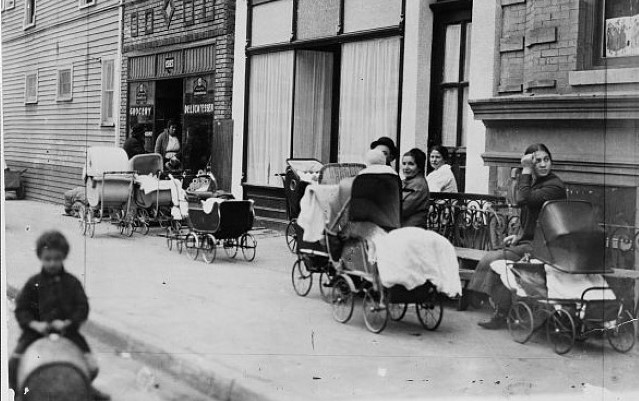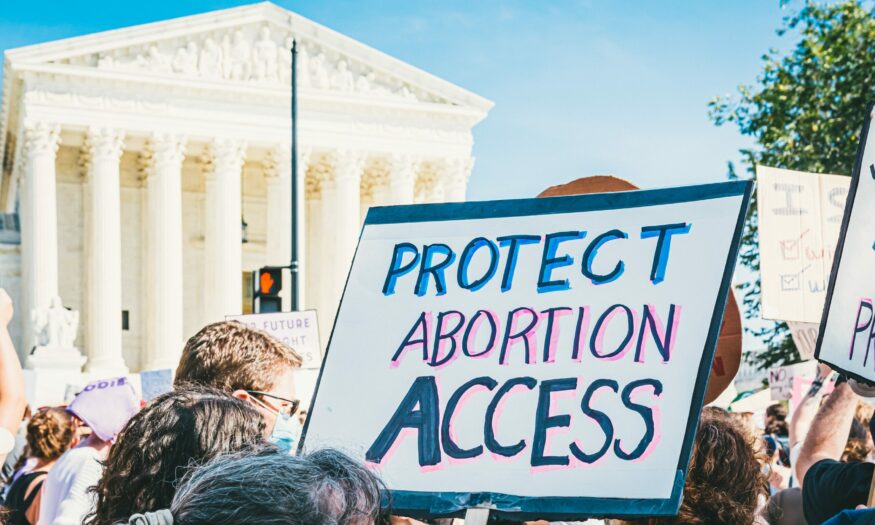A Brief History of Birth Control
 Women waiting outside the first birth control clinic in the U.S., in Brooklyn, NY, October 1916. Photo: New York World-Telegram and the Sun Newspaper Photograph Collection at the Library of Congress
Women waiting outside the first birth control clinic in the U.S., in Brooklyn, NY, October 1916. Photo: New York World-Telegram and the Sun Newspaper Photograph Collection at the Library of Congress
-
Topics Include:
Birth Control
Bodily Autonomy
Contraception & Abortion
History
Special thanks to Carrie N. Baker and Kirsten Thompson
People have long tried many methods to prevent pregnancy. These efforts, however, have often been constrained by governments, religious institutions, medical professionals and others seeking to control reproduction by blocking access to contraception and/or coercively imposing it on certain populations. Prior to reliable modern methods of birth control, people relied on withdrawal or periodic abstinence. These methods often failed.
Around 3000 BCE Ancient societies, including Crete and Egypt, begin developing condoms made from animal and fish bladders or intestines and linen sheaths.
Around 1850 BCE Egypt develops one of the first spermicides by combining crocodile dung and fermented dough. The low pH of the dung may have had a spermicidal effect.
1619-1870 Black women draw upon African folk remedies to create medicines that are shared and spread among enslaved populations to resist coerced reproduction by white men.
1855 The first rubber condom is produced.
1873 Congress passes the Comstock Act, which criminalizes using the U.S. Postal Service to mail any obscenity, contraceptives, abortifacients, or sex toys and authorizes the postal service to confiscate birth control sold through the mail. The law’s chief proponent and namesake Anthony Comstock becomes a special agent for the U.S. Postal Service to enforce the law. Many states pass similar laws in the following years.
1907 The United States institutes public policies that give the government the right to sterilize “unwilling and unwitting” people. Indiana enacts the nation’s first compulsory sterilization law in 1907; by 1929, thirty states have similar laws. These laws list the “insane,” the “feeble-minded,” the “dependent,” and the “diseased” as incapable of regulating their own reproductive abilities, therefore justifying government-forced sterilizations. State officials use these laws disproportionately to target Black women, Native American women and poor women and girls.
1914 Believing that “enforced motherhood is the most complete denial of a woman’s right to life and liberty,” public health nurse Margaret Sanger coins the term “birth control” and begins her decades-long campaign to make contraceptives legal and available to women in America.
1916 Margaret Sanger opens the first birth control clinic in the United States in Brownsville, Brooklyn. The next year, a New York court convicts Sanger of “maintaining a public nuisance” by dispensing contraceptive devices and sentences her to jail for 30 days. Once released, Sanger re-opens her clinic and continues to persevere through more arrests and prosecutions. In 1917, she begins publishing the magazine Birth Control Review to educate the public about contraception.
1918 In the case of People v. Sanger, the New York State Court of Appeals reverses the criminal conviction of Margaret Sanger, ruling that New York’s limitations on the distribution of birth control are unconstitutional because they infringe upon women’s liberties by forcing them to conceive more children than they want.
1918 African American women of the Women’s Political Association of Harlem hold their first public lecture on birth control.
1920 Margaret Sanger publicly states that “birth control is nothing more or less than the facilitation of the process of weeding out the unfit [and] of preventing the birth of defectives.” Despite disagreeing with some of the ideas of the eugenicists, who were part of the mainstream scientific establishment of the day, Sanger sought legitimacy for her controversial demand for birth control by aligning with them.
1921 Sanger founds the American Birth Control League, the precursor of Planned Parenthood, at the First American Birth Control Conference in New York City.
1927 The Supreme Court rules in Buck v. Bell that coercive sterilization does not violate the U.S. Constitution. To justify the decision, Oliver Wendall Holmes, Jr. infamously says, “three generations of imbeciles are enough.”
1936 The U.S. Court of Appeals for the Second Circuit in U.S. v. One Package rules that the federal Comstock law violates the U.S. Constitution.
1938 Diaphragms, also known as “womb veils,” become a popular method of birth control.
1939 By this year, nearly 400 community-based and state-sponsored birth control clinics exist throughout the country.
1939–1942 Several national groups advocating for birth control join together in 1939 to form the Birth Control Federation of America. In 1942, the organization changes its name to Planned Parenthood Federation of America.
1941 The National Council of Negro Women becomes the first national women’s organization to officially endorse the practice of contraception.
1950 While in her 80s, Sanger organizes support for research to create the first birth control pill.
1953 Biologists John Rock and Gregory Pincus team up to develop the birth control pill, funded by two million dollars from philanthropist Katharine Dexter McCormick. Because state laws prohibiting contraceptive research made it extremely difficult to set up trials, Rock and Pincus controversially first test the drug on male and female patients at the Worcester State Psychiatric Hospital in Massachusetts and then on poor women in Puerto Rico.
1960 The first oral contraceptive, Enovid, a mix of the hormones progesterone and estrogen, is approved by the U.S. Food and Drug Administration (FDA). It quickly became known simply as “the Pill.”
1965 The Supreme Court rules in Griswold v. Connecticut that married couples have a Constitutional right to privacy that includes the right to use birth control. However, millions of unmarried women are still denied birth control.
1965 The U.S. Agency for International Development’s population and reproductive health program begins, with the goal of reducing birth rates in developing countries.
1968 The FDA approves intrauterine devices (IUDs), bringing early versions called the Lippes Loop and Copper 7 to the market. Within a few years, more than 10 percent of women using contraception had IUDs.
1969 Medical journalist Barbara Seaman’s book, “The Doctor’s Case Against the Pill,” lays out testimony and research showing that the high doses of estrogen in the early Pill put women at risk of blood clots, heart attacks, strokes, and cancer.
1970 At well publicized Congressional hearings, feminists challenge the safety of the contraceptive pill. Afterward, hormones in the Pill are lowered to a fraction of the original doses.
1970 Congress passes Title X of the Public Health Service Act, creating a federal grant program dedicated solely to providing low-income individuals with comprehensive family planning services, including contraceptives, and related preventive health services.
1970 Toni Cade Bambara’s essay “The Pill: Genocide or Liberation?” calls attention to race and gender controversies surrounding contraception in communities of color.
1970s The Indian Health Services sterilizes thousands of Native American women, contributing to a drop in Native women’s average birth rate from 3.7 children in 1970 to 1.8 by 1980. By comparison, white women’s average birth rate was 2.42 in 1970 and 2.14 in 1980.
1972 The Supreme Court in Eisenstadt v. Baird legalizes birth control for unmarried people.
1973 The coercive sterilization of African American sisters Minnie Lee and Mary Alice Relf, aged 14 and 12, spark a lawsuit and a national campaign to end sterilization abuse. The Committee to End Sterilization Abuse (CESA) is founded a year later to combat coercive sterilization of women of color.
1974 The FDA suspends the sale of the Dalkon Shield IUD after four years on the market, after multiple users develop severe infections and at least seven women die. Although other IUD designs are not implicated, in subsequent years most IUDs are slowly taken off the U.S. market due to the escalating costs of lawsuits.
1975 Loretta Lynn releases her controversial country music hit “The Pill.”
1978 The Supreme Court in Carey v. Population Services holds that states cannot constitutionally place any restrictions on the advertisement, sale, and distribution of contraceptives to individuals of any age.
1979 The Department of Health, Education and Welfare releases new regulations requiring informed consent for sterilization procedures, including a 30-day waiting period.
1980s The FDA approves new low-dose hormonal contraceptive pills and a new copper IUD, ParaGard. People become increasingly aware of the Yuzpe regimen for emergency contraception, which entails taking multiple birth control pills within 72 hours of intercourse in order to prevent ovulation.
1991–1992 The FDA approves Norplant, the first long acting reversible contraception (LARC) in 1991. Surgically implanted as a set of small, soft tubes under the skin of the upper arm, Norplant releases the hormone levonorgestrel, which prevents pregnancy for five years. In 1992, the FDA approves another LARC, Depo Provera, a birth control shot that contains the hormone progestin and is taken every 3 months.
LARCs are lauded because they are highly effective in preventing pregnancy, last for an extended period of time, and once inserted, work without user action. However, like involuntary sterilization, doctors, judges and policymakers have at times coercively used LARCs against people of color and low-income people, especially teens in urban areas, as well as immigrants and disabled people.
1993 The FDA approves the first female condom, the FC1, a pouch that is inserted into the vagina before intercourse to prevent pregnancy and reduce the risk of sexually transmitted infections.
1998–1999 The FDA approves Preven (in 1998) and Plan B (in 1999), the first brands of emergency contraception that can used after intercourse to prevent pregnancy.
2000s Rapid expansion in method availability and improvements in safety and effectiveness lead to the FDA approving a new levonorgestrel-releasing IUD called Mirena in 2000, the hormonal patch Ortho Evra in 2001, the vaginal ring Nuvaring in 2001, a method of transcervical female sterilization called Essure in 2002, a single-rod implant named Implanon in 2006, and an improved female condom FC2 in 2009.
2002 Wyeth Pharmaceuticals takes the first hormonal implant, Norplant, off the U.S. market because of controversy related to its side effects and risks.
2006 The FDA approves over-the-counter sales of the emergency contraception Plan B for people aged 18 and over.
2010 Congress passes the Affordable Care Act, prohibiting sex discrimination in health insurance and requiring coverage of all preventive health care without copays. In 2011, the Obama administration issues regulations defining preventive health care to include coverage of all FDA-approved forms of contraception.
2010s The FDA approves a new emergency contraceptive pill called ella in 2010 and a new levonorgestrel-releasing IUD called Skyla in 2013. People increasingly use the copper IUD for emergency contraception.
2013 The FDA approves over-the-counter sales of the emergency contraception Plan B for people under the age of 18.
2013 North Carolina creates the Office for Justice for Sterilization Victims to compensate victims of forced sterilization. A year later, Virginia becomes the second state to do so when it creates the Victims of Eugenic Sterilization Compensation Program.
2014 The Supreme Court rules in Burwell v. Hobby Lobby Stores that employers with religious objections can refuse to cover contraception in their health insurance plans.
2017 The Trump administration expands the religious exemption from the ACA contraceptive mandate to employers of any size, even publicly traded businesses, and adds an exemption for moral objections of any kind as well.
2019 The Trump administration imposes a “domestic gag rule” on Title X health care clinics providing contraceptives to low-income women, resulting in a fifty percent decrease in the availability of reproductive health services in communities across the country.
2020 The Supreme Court in Trump v. Pennsylvania upheld the Trump administration’s religious and moral exemptions to the Affordable Care Act’s contraceptive mandate, blocking access to insurance-covered birth control for tens of thousands of people across the country and disproportionately harming low-income women.
2022 The Supreme Court in Dobbs v. Jackson Women’s Health Organization overturned Roe v. Wade (1973) and Planned Parenthood v. Casey (1992) arguing that the Constitution does not protect the right to abortion. In his concurrence, Clarence Thomas wrote that the Supreme Court “should reconsider … Griswold,” calling it one of several “demonstrably erroneous decisions.” Thomas is contending that the Supreme Court should reexamine whether people have the right to contraception.
Today More research is needed on user-controlled methods that protect against STIs and on birth control for men. Barriers to accessing reliable contraception remain for people worldwide.






